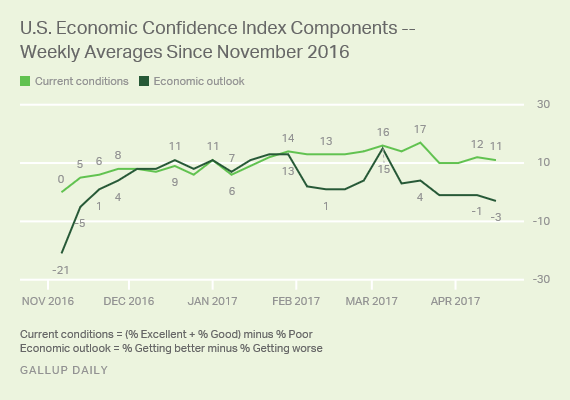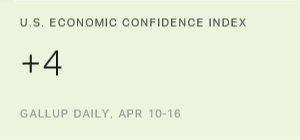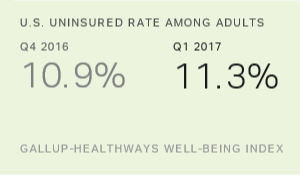Story Highlights
- Index is at +4, similar to +5 and +6 scores in prior weeks
- Confidence is at its lowest point since post-election score in November
- Economic outlook component retreats further
WASHINGTON, D.C. -- Americans' confidence in the U.S. economy remains slightly positive, but it has not recovered from the dip it took after peaking in March. Gallup's U.S. Economic Confidence Index was at +4 for the week ending April 16, showing no improvement from the +5 and +6 scores recorded in the past three weeks.

Economic confidence is back to where it was shortly after President Donald Trump won the election in mid-November, when the index hit +4 due to surging Republican optimism.
Since then, confidence has remained strong, with the index reaching a high point of +16 in early March as the stock market hit record highs. In the ensuing weeks, however, U.S. confidence has waned as the stock market's improvements have partially dissipated.
Though the index is at its lowest point in five months, it remains well above most of the negative scores it received from January 2008 to November 2016.
Gallup's U.S. Economic Confidence Index is the average of two components: how Americans rate current economic conditions and whether they feel the economy is improving or getting worse. The index has a theoretical maximum of +100 if all Americans were to say the economy is doing well and improving, and a theoretical minimum of -100 if all were to say the economy is doing poorly and getting worse.
For the week ending April 16, 33% of Americans assessed the economy as "excellent" or "good," and 22% rated it as "poor," resulting in a +11 current conditions score -- similar to its +12 score from the previous week.
Meanwhile, Americans have become slightly more pessimistic than optimistic about the economy's future. Nearly half (48%) said the economy was "getting worse," while 45% said it was "getting better." As a result, the economic outlook component of Gallup's index averaged -3, down slightly from the previous three weeks' scores of -1 -- and the lowest reading for this component since early November.

Bottom Line
Americans' assessments of the current state of the economy appear to have had a strong connection to the trajectory of the Dow Jones industrial average in recent months. Positive perceptions of the economy's current health peaked in early March after the stock market made strong gains in January and February, but have since retreated some as the market slipped. Americans' outlook for the economy's future continues to struggle.
Given that the economic outlook component has largely driven the index's recent decline, it may take some positive economic news to give Americans the impression that their economy will be strong in the long run, which would improve overall confidence.
These data are available in Gallup Analytics.
Gallup.com reports results from these indexes in daily, weekly and monthly averages and in Gallup.com stories. Complete trend data are always available to view in the following charts:
Daily: Employment, Economic Confidence, Consumer Spending
Weekly: Employment, Economic Confidence, Job Creation, Consumer Spending
Read more about Gallup's economic measures.
View our economic release schedule.
Survey Methods
Results for this Gallup poll are based on telephone interviews conducted April 10-16, 2017, on the Gallup U.S. Daily survey, with a random sample of 3,048 adults, aged 18 and older, living in all 50 U.S. states and the District of Columbia. For results based on the total sample of national adults, the margin of sampling error is ±2 percentage points at the 95% confidence level. All reported margins of sampling error include computed design effects for weighting.
Each sample of national adults includes a minimum quota of 70% cellphone respondents and 30% landline respondents, with additional minimum quotas by time zone within region. Landline and cellular telephone numbers are selected using random-digit-dial methods.
Learn more about how the Gallup U.S. Daily works.




